A major group of tree plants bearing seeds and cones is the Conifer. More than 650 species are belonging to this genera. The family known for these tree plants is Coniferae; which originates from the division Coniferaphyta (also termed Pinophyta).
Conifers are gymnosperms (producing seeds); also bear cones (a sub-class of gymnosperm). Economically important tree plants are included in this group. There are some examples of the tree belonging to Conifers; Cedar, Douglas-firs, Hemlocks, Redwoods, Cypress Pines, Larches, some Yews, and Junipers. Conifers include large tree plants with a distinct feature of secondary growth. In which, annual growth rings are produced from the division of cambium and meristems.
Regions of Taiga, major land areas such as the Northern Hemisphere, and Coniferous Rain Forests are famous for the massive production of the Conifers. These are evergreen plant trees. The specific shape of the leaves that appeared is more or less like a needle.
The division of more than 600 species is majorly based on the size shape and appearance of the leaves and the shape of their foliage. Different species of Spruces, Yews, Pines, Firs, Cedars, Hemlock, Junipers, and Cypress are shown in the figure below.
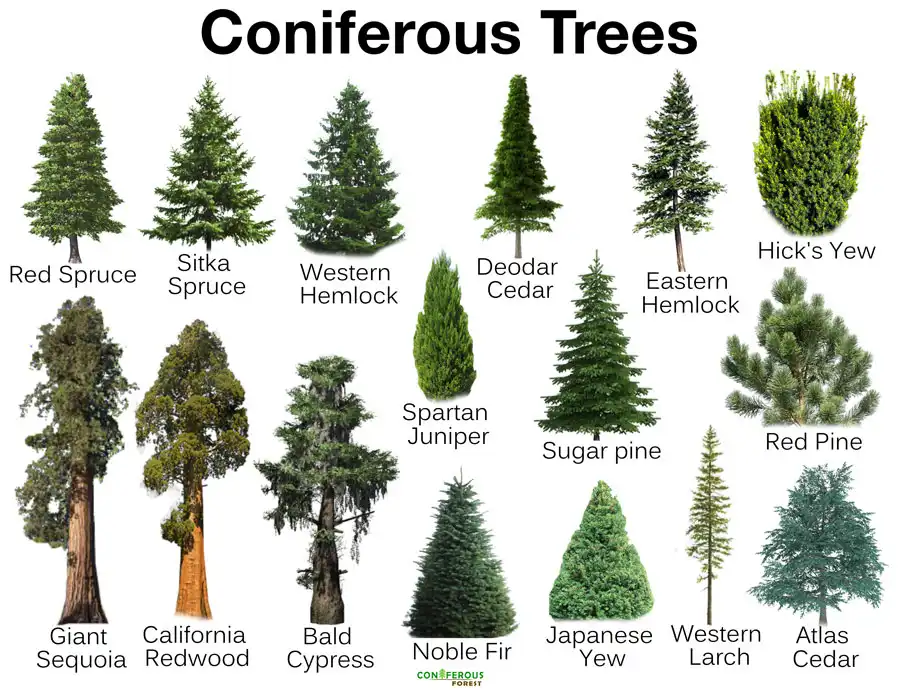
Conifers are from perennial woody plants. The specific cone shape of the tree; expanding from the top thin part to the lower thicker and wider bottom foliage, helps these trees to get rid of heavy snowfall. These are resistant to cold climates and grow well in relatively lower temperature ranges because of their biochemistry which has made Conifers cold-resistant.
A suitable classification is done for separating the classes of Conifer trees. That classification divides Conifers into three orders. 1st Pinales, 2nd Cupressales, and 3rd Araucariales. Some of the species have long thin needle-like leaves, some have flat, little broader leaf shapes while some group of conifers trees has flat triangular leaves in shape.
The leaves in the foliage of Conifers are dark green, enabling them to absorb maximum light energy. Stomata are not spread on full leaves rather these are in the form of small patches on the lower side of the leaves which help to store water content in dry conditions.

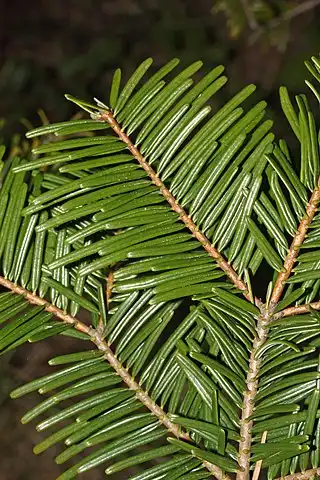
In the basic structure of the Conifer tree, one main stem is observed. This main stem is divided into a small number of further branches. A chemical produced by these conifer trees named resin provides Conifers with protection against insects.
Softwood is obtained from Coniferous trees. Almost 50% of the World’s demand for lumber wood is fulfilled from these Conifer trees. In fruits the Juniper berries and nuts of the pine trees, pine nuts are consumed as food in several regions of the World.
Spruce, Yews, Pines, Cedars, and Abies are now cultivated all over the World as ornamental tree plants because of their shape, size, and appearance. Another fun fact related to Conifers is that this group includes the oldest, biggest, tallest, and thickest trees in it[1]Waring, R.H. and J.F. Franklin, Evergreen coniferous forests of the Pacific Northwest. Science, 1979. 204(4400): p. 1380-1386. Read.
Famous varieties of Conifer trees
1. Pinus radiata
It is native to the regions of Australia, New Zealand, Spain, Mexico, and some areas of California. The height of the tree ranges from 12 to 32 meters. It loves to grow in temperate forests. It is famous for its high-quality pulp and lumber for industrial uses[2]Burdon, R., Pinus radiata. Ecosystems of the world, 2001: p. 99-162. Read.
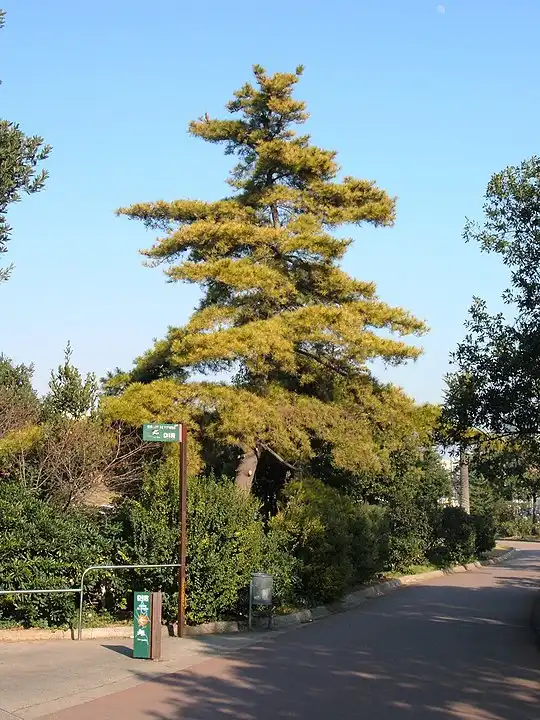
2. Douglas fir (Pseudotsuga menziesii)
It is also called Columbian pine, Abies, and False hemlock. North America is the native region for its growth. It is a common food source for small mammals and animals. These are sensitive to light, and medium in size[3]Franklin, J.F., et al., Disturbances and structural development of natural forest ecosystems with silvicultural implications, using Douglas-fir forests as an example. Forest ecology and management, … Continue reading.
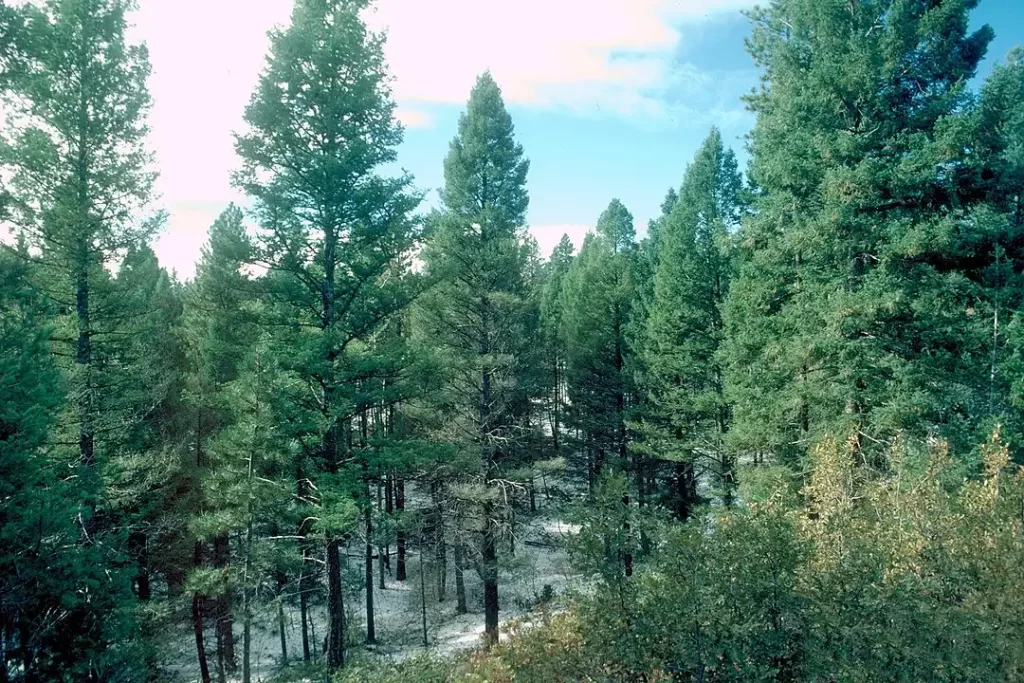
3. European larch (Larix decidua)
European larch is commonly found in central Europe and is also native to Poland. The oldest trees are associated with this species. The age can cross the mark of 1000 years and more[4]Lévesque, M., et al., Drought response of five conifer species under contrasting water availability suggests the high vulnerability of Norway spruce and European larch. Global Change Biology, 2013. … Continue reading.
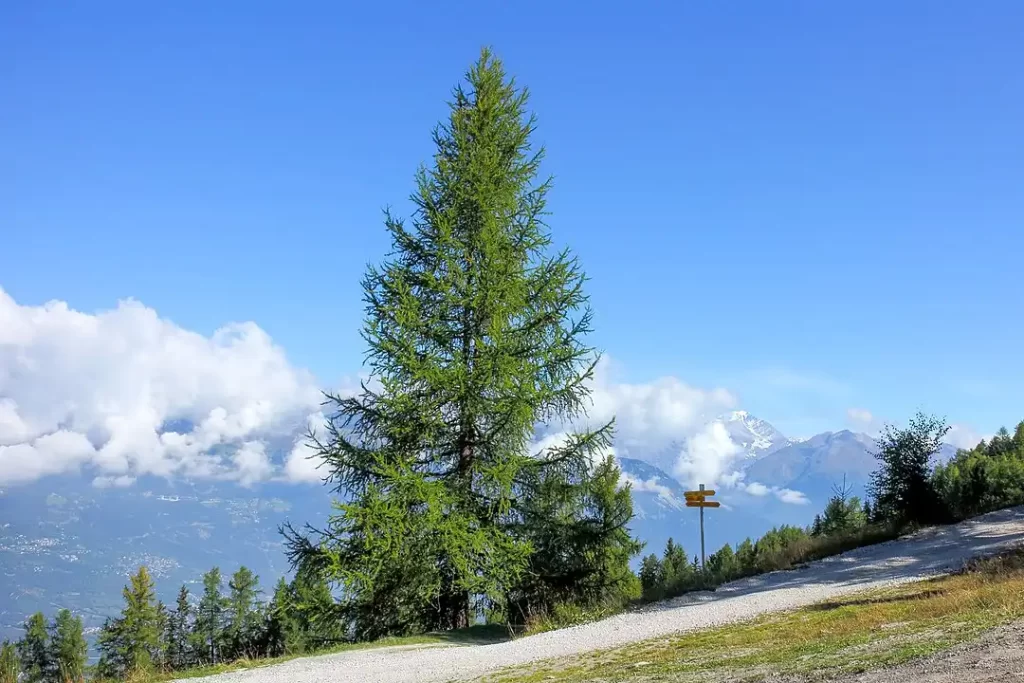
Reproduction and life cycle of Conifer trees
Conifers are naturally spread by winds, seeds are spread through the air because they are light in weight. Some of the conifers are monoecious some are dioecious, and sub-dioecious are also observed.
A plant organ called the strobilus is the place where seeds are formed. 2-620mm long cones are matured in a few weeks to 4 years to reproduce further. In some of the plants, the Conifers may produce, woody cones with hard scales on them which help in dispersal and seed fall. While some are famous for producing berries or soft fleshy fruits with scales.
In the soft-bearing conifers, the seed spread with the help of birds eating that fleshy fruit resulting in dropping full of seeds. Wherever the birds will fly, they will help in spreading the seeds of Conifer trees.
Seed propagation of Conifer trees
Male cones are relatively smaller in size and female cones are larger. Male cones are grown below while female cones are developed at the upper side of the trees. Male cones produce pollen, which is yellow to orange or pale yellow; termed male flowers. Female cones are larger and unfertilized; termed female flowers.
Microsporangia is the male cone structure that is related to pollen production and spread. Winds help the pollen to reach the female cones and fertilize them. The area where fertilization is completed in female cones is called the micropyle. A zygote is developed leading to the production of fruits and seeds afterward.
To summarize the life cycle of conifers, we can say the pollen from the male cone or male flower is used to fertilize the female flowers due to which the zygote is developed. Seeds and embryos within seeds are developed (as seen in spermatophyte).
Seeds when dried and consumed by birds spread through wing and bird’s droppings respectively. Seeds are germinated, and the new plant is developed thus the cycle goes on[5]Owens, J.N., T. Takaso, and C.J. Runions, Pollination in conifers. Trends in plant science, 1998. 3(12): p. 479-485. Read.
Artificial propagation
1. Cutting
The method is favorable for conifer plants with a strong root system. It is also a time-consuming method because it can take a whole year for the development of the root system. Once a proper root system is developed, the plant is ready to be planted in the soil.
The fresh cutting is taken with the help of sharpened shears. 8 to 10 cm long soft branches with 2 to 5 small leaves are selected and neatly cut with the shears. A well-moisturized soil in a pot with proper nutrient contents is prepared for the plantation of the cutting. The soil is kept in a pot and a small depression is created with the help of a thing stick according to the thickness of the cutting. The pot is placed indoors, and this method is adopted in the winter season when the moisture contents of the air and soil can be maintained at a high level.
The benefit of the cutting method is the exact clone is made of that parent plant. The other basic advantage of cutting is that the plants grow more quickly than the seed or grafting method, they become large and strong.
2. Grafting
In this method, cuttings of two plants (one having a strong root system and the second with a strong aerial part, canopy, and strong stem) are joined through their cut sides and bound together with plastic cover sheets. The plant grows from the cut sides and tries to heal itself. With this healing mechanism, plants from which cutting was taken are fused and xylem and phloem systems are conjoined.
This method is helpful when the plant being propagated has a weak root system but a strong shoot system. The process is done indoors with suitable winter conditions necessary for plant survival[6]Bonga, J., Conifer clonal propagation in tree improvement programs. Vegetative Propagation of Forest Trees; Park, Y.-S., Bonga, JM, Moon, H.-K., Eds, 2016: p. 3-31. Read.
Care and tips for healthy growth of ornamental conifers
- Nitrogen content in the soil determines the seed quality and its dry weight. Nitrogen in the form of ammonium ions and nitrates is important to enhance the speed of seed and cone production.
- The nitrogen supply is maintained in the soil after regular soil chemistry analysis with the help of ammonia and nitrogen-based fertilizers. It is recommended to add 50 to 120 g of fertilizer in the soil per meter square.
- The other elements such as magnesium, sulfur, phosphorous, and potassium are also used in bulk amounts in the soil after regular intervals.
- Mulching is also done to prevent plant loss due to nutrient competitor plants, weeds. Mulching also helps the plant to conserve the food and moisture content.
- Proper watering is done to keep the moisture content in balance.
- Some varieties require full sunlight such as green or blue foliage varieties. Light-colored foliage is sensitive to longer durations of sunlight.
- The shape of conifer ornamental varieties is also maintained with the help of timely pruning[7]Welch, H.J., The Uses and Value of Conifers, in The Conifer Manual. 1991, Springer. p. 18-30. Read.
Diseases of Conifer trees
Major problems faced by Conifer trees are related to fungal infections. These disease conditions are economically important because any damage to the softwood supply to the industries will result in a decrease in gross domestic production (GDP). Some of the important diseases are discussed below:
1. Spruce Needle Casts
The major victim of this fungal infection is Colorado blue spruce. The causative fungal agents responsible for this infection are Rhizosphaera and Stigmina. Leaves of the foliage show needle-like growth inside of the cells. This fungal infection is prominent in the areas where there is any kind of major ecological stress nearby.
Stressed trees are more susceptible to infection. The tree dies when the needle-like fungal growth shows extended growth. To cure this, primary management is to remove that stress which was responsible and apply regular fungicidal.
2. Douglas fir-related Canker and Rust of junipers
Cedars and Douglas firs are damaged by the fungus of the genus Gymnosporangium. This results in gall production at the joined points of the branches. It can be cured by simple pruning and fungicidal spray. In canker disease caused in pines and fir trees, the tree branches die off. The fungus gets the plant disuse killed. Black peel-off is observed. It spread eventually to the main trunk of the tree. The cure again is fungicidal sprays.
3. Pine wilting
The insect pests and nematodes feeding on roots are the reasons for pine trees wilting. An arthropod pest vector named, the Pine sawyer beetle severely damages the soft tissues, especially the vascular tissues of the plant. Nematodes also are transferred on this beetle. Insecticides are recommended. Nematodes are treated to save the plant from wilting[8]Carroll, F., E. Muller, and B. Sutton, Preliminary studies on the incidence of needle endophytes in some European conifers. Sydowia, 1977. 29(87): p. 103. Read.
Uses of Conifer trees
- Provide food, fuel, and excellent quality wood pieces to build furniture and wood materials as house decors.
- Trees are used on Christmas Eve.
- Its pulp is used in the paper industry.
- Source of organic compounds.
References
| ↑1 | Waring, R.H. and J.F. Franklin, Evergreen coniferous forests of the Pacific Northwest. Science, 1979. 204(4400): p. 1380-1386. Read |
|---|---|
| ↑2 | Burdon, R., Pinus radiata. Ecosystems of the world, 2001: p. 99-162. Read |
| ↑3 | Franklin, J.F., et al., Disturbances and structural development of natural forest ecosystems with silvicultural implications, using Douglas-fir forests as an example. Forest ecology and management, 2002. 155(1-3): p. 399-423. Read |
| ↑4 | Lévesque, M., et al., Drought response of five conifer species under contrasting water availability suggests the high vulnerability of Norway spruce and European larch. Global Change Biology, 2013. 19(10): p. 3184-3199. Read |
| ↑5 | Owens, J.N., T. Takaso, and C.J. Runions, Pollination in conifers. Trends in plant science, 1998. 3(12): p. 479-485. Read |
| ↑6 | Bonga, J., Conifer clonal propagation in tree improvement programs. Vegetative Propagation of Forest Trees; Park, Y.-S., Bonga, JM, Moon, H.-K., Eds, 2016: p. 3-31. Read |
| ↑7 | Welch, H.J., The Uses and Value of Conifers, in The Conifer Manual. 1991, Springer. p. 18-30. Read |
| ↑8 | Carroll, F., E. Muller, and B. Sutton, Preliminary studies on the incidence of needle endophytes in some European conifers. Sydowia, 1977. 29(87): p. 103. Read |



